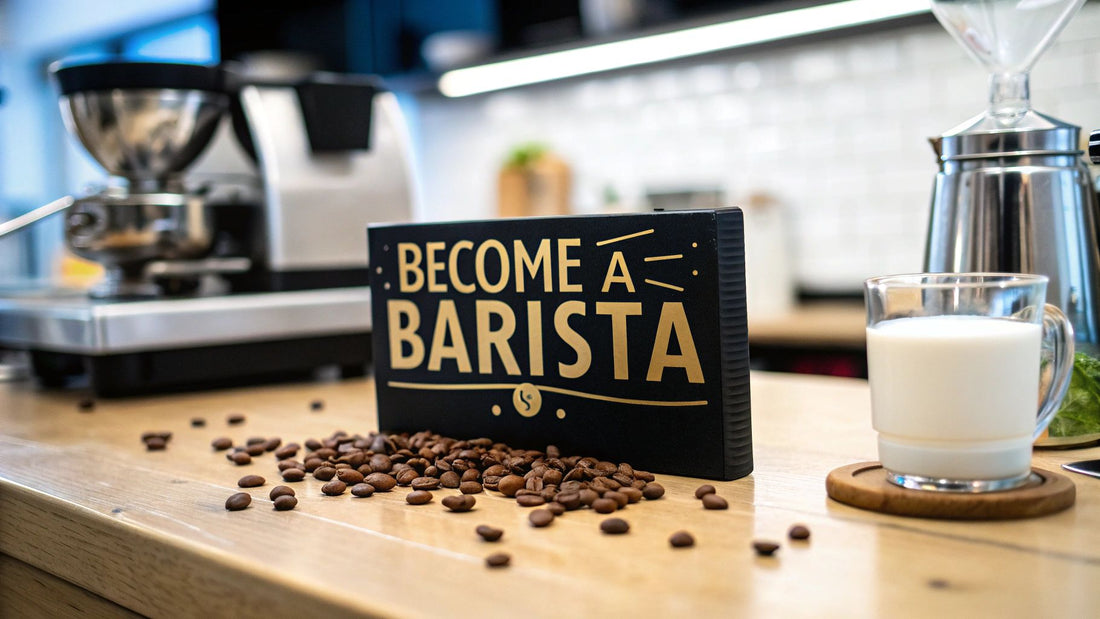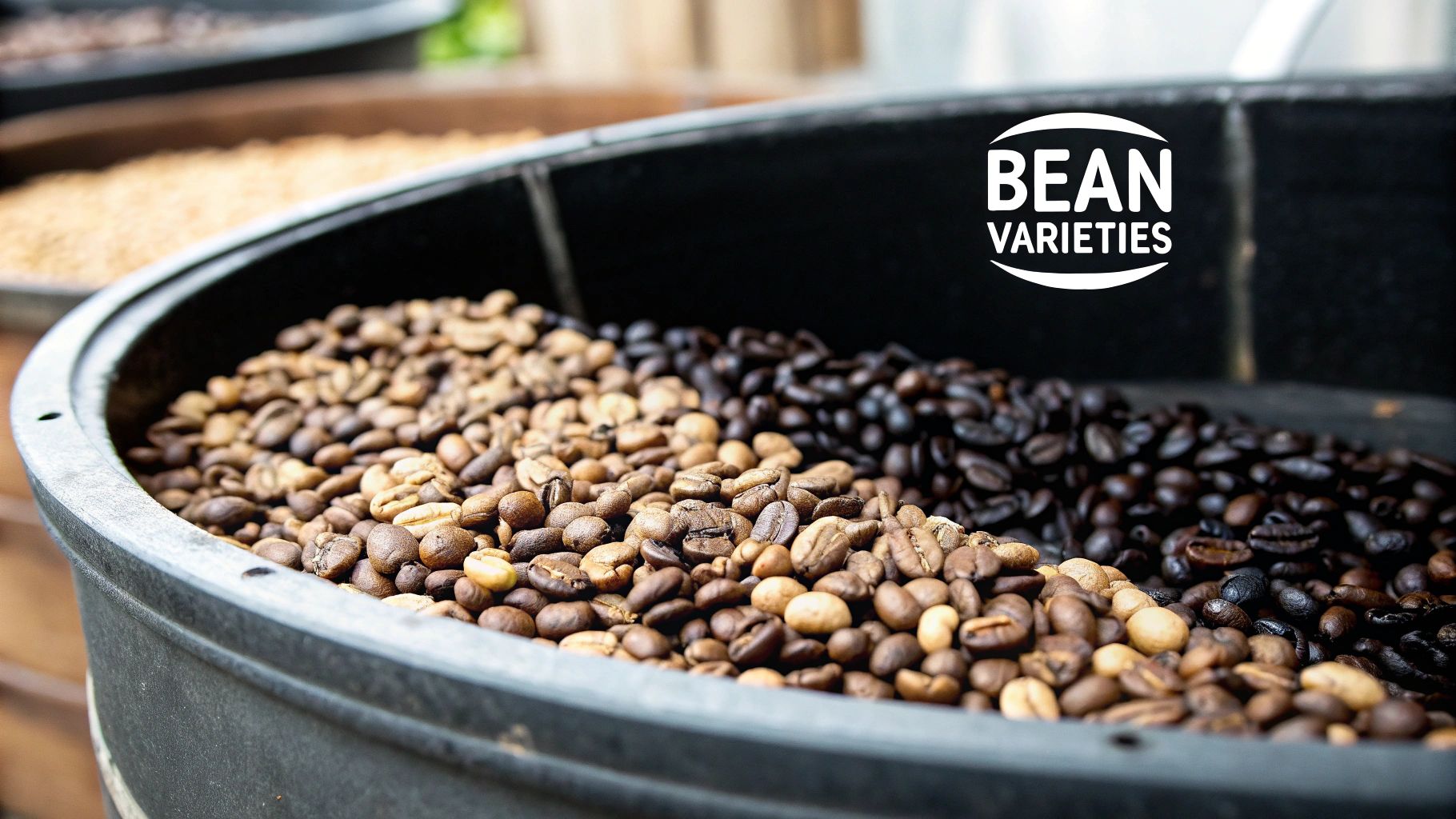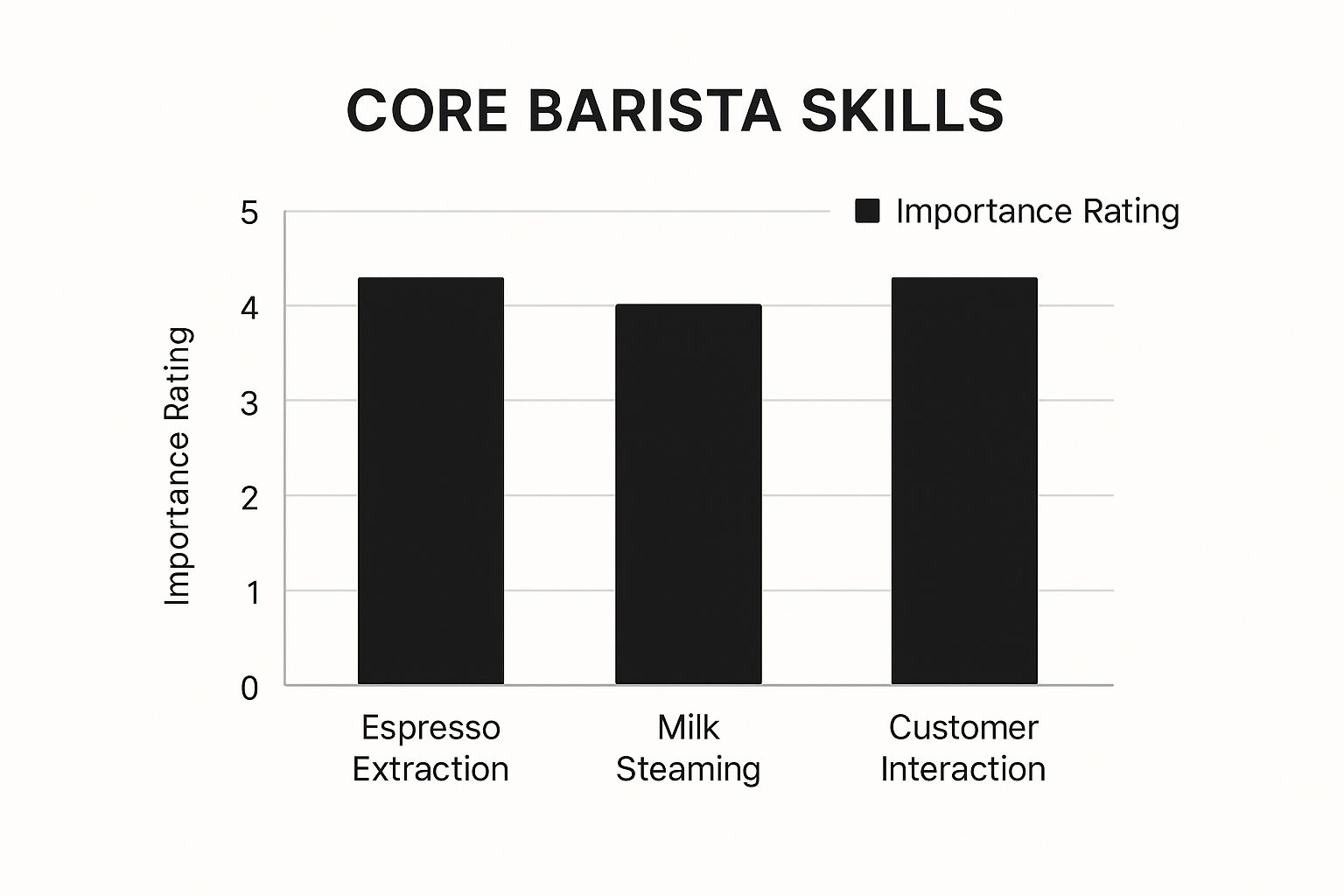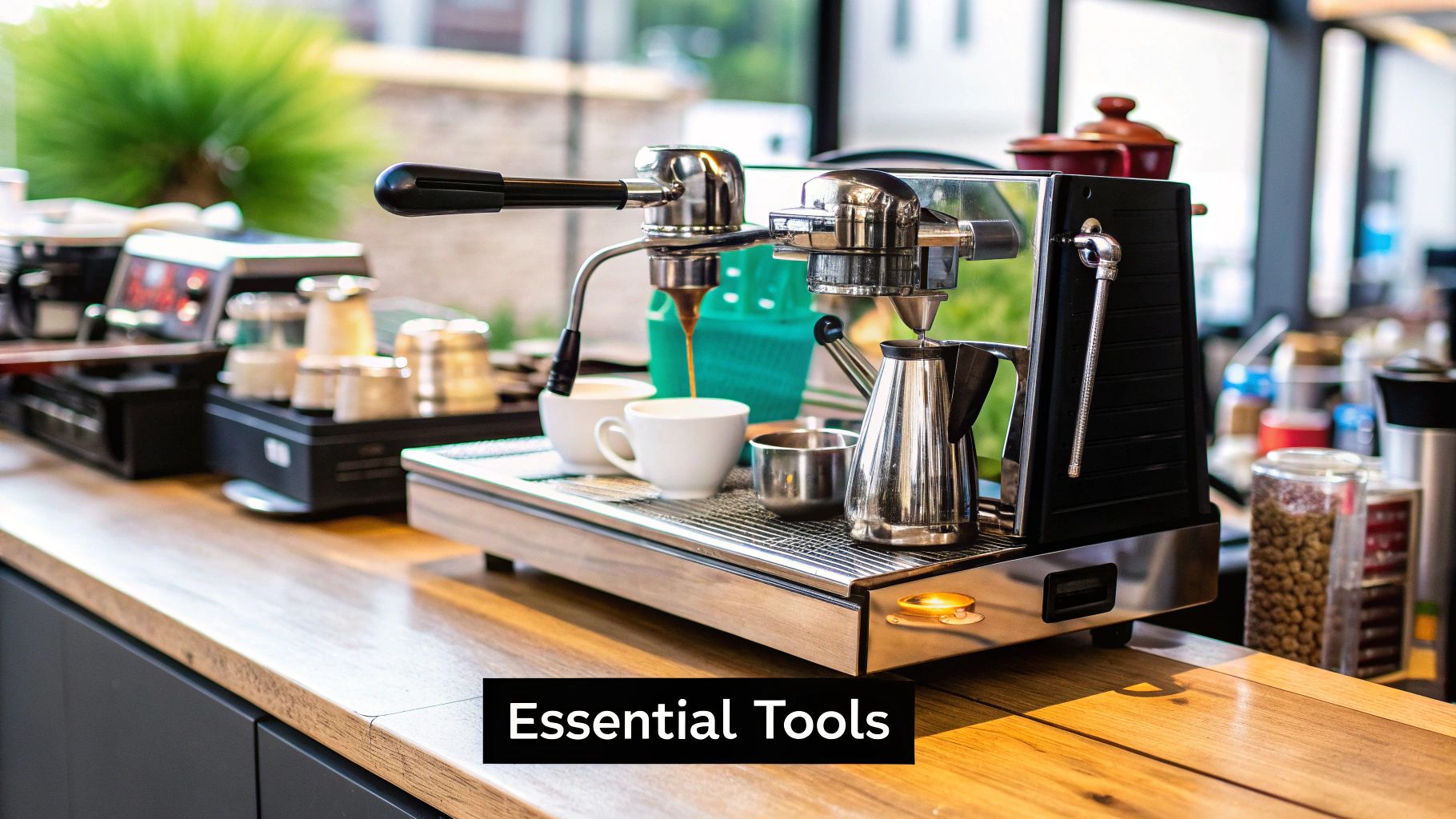
How to Become a Barista: A UK Guide
Share
Picture this: the low hum of a coffee grinder, the rich aroma of a freshly pulled espresso shot, and that little moment of pride when you hand over a perfectly crafted flat white. The path to becoming a barista is so much more than a job; it's about joining the UK's vibrant speciality coffee culture and learning a genuine craft.
Your Start in the UK Coffee Scene
This guide is your roadmap. We’re going to look past the romantic notions and get straight to the real, practical steps you need to take to get started. We'll cover everything from the journey of the coffee bean itself to mastering the espresso machine and, finally, landing your first gig in a bustling UK café. Think of this not just as a career path, but as a craft you can build with passion and dedication.
The UK coffee industry is always buzzing and growing, which makes it a fantastic place for aspiring pros. It’s certainly a competitive field, but it’s one that really rewards skill and a true love for what you're doing. Understanding just how healthy the market is can really open your eyes to the potential here.
A Growing Market Full of Opportunity
Let's be clear: the demand for high-quality coffee has never been higher. The UK's branded coffee shop market is now valued at a massive £6.1 billion, with over 11,400 outlets across the country—that's a huge 16% increase in just two years.
This boom is driven by our changing habits, with 60% of coffee drinkers now popping into cafés multiple times a week. This consistent growth means more doors are opening for new talent all the time. If you want to dive deeper, the World Coffee Portal has some great insights into the UK market's impressive growth.
Your passion for coffee is the most valuable asset you have. Skills can be taught, but genuine enthusiasm for the craft is what truly sets a great barista apart from a good one. It’s what customers notice and what employers look for.
What to Expect on Your Journey
So, how do you get from coffee lover to coffee professional? The journey involves a few key stages, each one building on the last. It’s a real blend of learning the theory and getting your hands dirty with practical skills.
To give you a clearer picture of what's ahead, here’s a quick overview of the journey.
Your Path to Becoming a Barista Quick Overview
This table breaks down the core stages of your journey, from that initial spark of interest to becoming a pro in the UK coffee scene.
| Stage | Key Focus | Outcome |
|---|---|---|
| Foundation Building | Understanding coffee origins, processing, and tasting notes. | Confidently discuss coffee with customers and colleagues. |
| Practical Skills | Mastering espresso extraction, milk steaming, and latte art. | Consistently produce high-quality beverages. |
| Professional Training | Seeking formal education or on-the-job experience. | Gaining credentials and refining your technique. |
| Job Search | Crafting a compelling CV and acing trial shifts. | Landing your first professional barista role in the UK. |
Each step is a chance to deepen your knowledge and hone your craft. It’s a rewarding process that combines technical skill with a genuine passion for hospitality.
Building Your Coffee Knowledge Foundation

A great barista knows their job starts long before they even touch the espresso machine. It begins with the bean itself—its origin, its journey, and the unique story it tells inside the cup. This deep-seated knowledge is what really separates a button-pusher from a genuine coffee professional, especially in the UK’s thriving speciality coffee scene.
Think of yourself as a coffee storyteller. When a customer is looking for a recommendation, you won’t just vaguely point at the menu. You’ll be able to explain exactly why that single-origin Ethiopian coffee has bright, almost tea-like notes of bergamot, while the Brazilian bean offers a comforting, chocolatey body that’s just perfect for a flat white. That’s the kind of insight that builds trust and makes the whole experience memorable.
From Bean to Cup: The Journey Matters
Every coffee has a backstory shaped by geography, climate, and the people who grew it. Getting your head around this "bean-to-cup" journey is essential if you're serious about the craft.
You'll quickly learn that a coffee’s origin is a massive clue to its flavour. For instance, beans from Central and South America—think Colombia or Brazil—often lean towards nutty and chocolatey profiles. Contrast that with African coffees, like those from Ethiopia or Kenya, which are famous for their vibrant acidity and fruity or floral notes.
This isn’t just trivia for impressing customers; it directly affects how you should brew the coffee. You wouldn't want to lose a delicate, floral Ethiopian bean in a big milky latte. It's going to shine as a pour-over or filter coffee. On the other hand, a bold Sumatran can hold its own beautifully.
Speaking the Language of Coffee
Beyond where the coffee is grown, the way it’s processed after being picked has a huge impact on the final taste. This is one of those key areas of knowledge that will really set you apart. In the UK market, you'll see a few main processing methods pop up again and again.
- Washed Process: The fruit is completely removed from the bean before it's dried. This gives you a really clean, bright cup that lets the bean's natural acidity and flavour clarity shine through.
- Natural Process: Here, the whole coffee cherry is dried with the bean still inside. All the fruit's sugars ferment and soak into the bean, creating intensely fruity, sweet, and often wine-like flavours.
- Honey Process: This is a happy medium where some of the fruit pulp is left on the bean while it dries. The result is often a cup with a syrupy body, a lovely balanced sweetness, and a softer acidity than a fully washed coffee.
Understanding processing is like a chef knowing whether to roast or steam their vegetables. The same ingredient can produce wildly different results. This knowledge lets you unlock the true potential of every coffee you serve.
Arabica, Robusta, and Roast Profiles
While Arabica beans are the stars of the speciality world, making up over 60% of all coffee grown, they aren't the whole picture. You also need to know about Robusta. It’s a hardier plant with a bold flavour, higher caffeine kick, and an amazing ability to produce a thick, stable crema, which is why you’ll often find it in traditional espresso blends.
Finally, the roast profile is the last piece of the puzzle. This is where the roaster coaxes out the bean's final character.
- Light Roasts: These roasts are all about preserving the coffee’s origin characteristics. Expect bright acidity and delicate floral or fruity notes. These are very popular in the UK speciality scene for filter coffee.
- Medium Roasts: This is where you find a bit more balance. You get a fuller body, a rounded sweetness, and a nice mix of origin flavours and notes developed during the roast. This is often the sweet spot for espresso in speciality shops.
- Dark Roasts: With these, you’re tasting the roast itself. Think bold, smoky, and chocolatey flavours, with lower acidity and a heavy body.
Grasping these fundamentals changes everything. It’s the difference between just following a recipe and truly understanding the art and science behind a perfect cup of coffee—a vital step on your way to becoming a skilled and respected barista.
Right, you've got the coffee theory down. Now for the fun part: getting your hands dirty and actually making a brilliant cup of coffee.
This is where you move from thinking like a barista to being one. It's about developing the muscle memory and instincts that turn knowledge into a tangible, delicious product. Talking about tasting notes is one thing; consistently pulling an espresso that sings with them is another entirely.
This is the heart of the craft—building a real connection with the grinder, the espresso machine, and the coffee itself. It’s a journey paved with practice, a fair bit of patience, and a willingness to learn from every single shot you pull.
The Art of Dialling In
If there's one skill that separates the pros from the amateurs, it's dialling in. This is the daily ritual of adjusting the coffee grind to pull the perfect espresso shot. Think of it as a delicate dance between science and your senses, all aimed at a single goal: an extraction that’s rich, syrupy, and perfectly balanced—not sour, not bitter, just right.
Imagine you’re a photographer focusing a lens. A grind that’s too coarse lets water gush through the coffee, leaving you with a watery, sour, under-extracted shot. Go too fine, and the water struggles to get through at all, resulting in a harsh, bitter, over-extracted mess. Your job is to find that elusive sweet spot.
In the UK speciality scene, you'll almost always start with a recipe. A common one is 18 grams of ground coffee in the basket, aiming for about 36 grams of liquid espresso in the cup, pulled in 27-32 seconds. Dialling in is simply the process of tweaking the grind—finer or coarser—to hit those numbers while, most importantly, making the coffee taste amazing.
Mastering Milk Steaming and Texture
Once you can pull a consistently great espresso, your next mountain to climb is milk. And I don’t just mean heating it up. We’re talking about creating perfect microfoam—that silky, velvety, paint-like steamed milk that gives a flat white its luxurious mouthfeel.
It all comes down to two key stages:
- Stretching: This is where you introduce air. By keeping the steam wand tip just below the surface of the milk, you'll hear a gentle hissing sound. This creates the foam and should only last a few seconds.
- Texturing: Next, you submerge the wand deeper to create a whirlpool. This vortex folds those air bubbles into the milk, breaking them down into a fine, glossy microfoam while heating it to the ideal temperature of 60-65°C.
Different drinks need different textures. A classic cappuccino requires a thicker, denser foam, so you’ll stretch the milk for longer. A flat white, which is a staple in every UK café, needs a much thinner, silkier microfoam that integrates seamlessly with the espresso.
The image below breaks down the core skills you'll be developing and how they stack up in a professional setting.

As you can see, technical skills like espresso extraction and customer interaction are paramount. They directly shape the quality of the drink and the customer's overall experience.
Pouring Foundational Latte Art
Latte art is the final flourish, the signature that tells your customer you’ve taken care. Before you start pouring intricate swans and tulips, though, you need to nail the basics. The two foundational patterns every barista must master are the heart and the rosetta.
You can't pour good latte art without perfectly steamed milk. It’s impossible. If your milk is bubbly or too thin, the patterns will just fall apart. The trick is to start pouring from a height to let the milk dive under the crema, then lower the jug right down to the cup’s surface so the white foam can sit on top and create the design. It's all about control, consistency, and a steady hand.
"Don't get discouraged if your first attempts look more like clouds than hearts. Every great barista has poured hundreds of messy, undefined blobs. Focus on getting the milk texture right first, and the art will follow."
Your Skills in the Wider UK Market
Developing these core skills is your ticket into the industry, whether you’re aiming for a quirky independent shop or a major high-street name. In the UK, the path to becoming a barista can begin in many different environments.
The major coffee chains create a huge number of entry-level jobs across the country. Because they need consistency across thousands of locations, they invest heavily in their own training programmes, which has raised the baseline skill level expected from new baristas everywhere. You can read more about the UK's cafe industry dynamics to get the full picture.
Even if your dream is to work in speciality coffee, getting experience in a high-volume chain is incredibly valuable. You’ll learn speed, efficiency, and how to handle a relentless queue—all essential skills for any busy café.
Practical Tips for Honing Your Craft
You don’t need to be behind a commercial machine to start learning. While nothing beats real-world experience, you can begin building your skills right now.
- Practise with Water: Before you go through cartons of milk, practise your steaming technique with cold water and a tiny drop of washing-up liquid. It mimics milk surprisingly well and helps you master the vortex without the cost.
- Watch and Learn: Go to good independent coffee shops and just watch the baristas. Notice their workflow, how they move, how they hold the milk pitcher. You can learn a lot by observing.
- Invest in a Home Setup: If you're serious about this, a decent home espresso machine and grinder can be a fantastic investment. It gives you the freedom to practise dialling in and steaming whenever you want.
- Taste Everything: The most important thing is to develop your palate. Try different coffees brewed in different ways. Go to "cuppings" (coffee tastings) at local roasteries. The more you taste, the better you’ll understand what you’re aiming for.
Mastering these skills isn't a one-and-done deal; it's a continuous process of refinement. It’s about chasing that perfect shot and pouring that flawless flat white, day in and day out. That dedication is what will set you apart.
Finding the Right UK Barista Training

You've got the coffee theory down and you've practised the basics. So, what’s next? It's time to formalise those skills. Stepping into the world of professional training is a smart investment in your future as a barista, giving you structure, expert feedback, and a credential that makes your CV pop in a competitive UK market.
Choosing the right path isn’t a one-size-fits-all deal. The UK has a brilliant range of options, from hands-on training at established coffee roasteries to intensive courses at dedicated barista schools. Each route offers a different blend of experience, cost, and qualification.
On-the-Job Learning Versus Formal Courses
One of the most common ways to break into the industry is through on-the-job training. Many independent cafés are happy to train passionate people from the ground up. This approach is fantastic because you earn while you learn, getting immediate, real-world experience in a busy café. You’ll master skills under pressure and get to grips with workflow efficiency and customer service right alongside espresso extraction.
On the other hand, dedicated barista schools offer a focused, distraction-free environment. These courses pack a ton of learning into a few days or weeks, giving you intensive hands-on time with high-end equipment and direct instruction from seasoned pros. They're ideal for fast-tracking your technical skills and getting a recognised qualification quickly.
Your choice really comes down to your learning style and financial situation. If you thrive in a fast-paced setting and need to earn straight away, on-the-job training is a great fit. If you prefer a structured curriculum to build a strong technical base before you start working, a formal course is an excellent investment.
The great news is that the UK coffee market is absolutely booming. Recent analysis shows the sector is set for continued expansion, with turnover expected to climb by 4.1% and the number of coffee shops forecast to top 12,200 by 2025. This growth means a steady demand for skilled professionals, making formal training a very wise move. You can learn more about the UK coffee market's growth and what it means for baristas.
What to Look for in a UK Barista Course
When you’re sizing up different training providers, look beyond the price tag. A quality course is an investment that should pay for itself in your career. Here’s a quick checklist to help you pick a winner:
- Hands-On Machine Time: This is the big one. How much time will you actually spend on the espresso machine and grinder? A good course maximises practical time over just sitting in a classroom.
- Small Class Sizes: You need individual feedback. A smaller group means the instructor can watch your technique, correct mistakes, and give you personalised advice.
- Comprehensive Curriculum: Does the course cover everything? Look for modules on dialling in, milk science, latte art, workflow, and basic machine maintenance.
- Experienced Instructors: Find out who’s teaching you. The best trainers have extensive, real-world experience as head baristas or café managers in the speciality coffee scene.
The Value of SCA Certification
As you explore training options, you’ll definitely come across the Specialty Coffee Association (SCA). The SCA offers a globally recognised, points-based diploma system covering everything from barista skills to brewing, sensory skills, and roasting.
Earning an SCA qualification, like the Barista Skills Foundation or Intermediate level, is a massive boost for your CV. It tells potential employers in the UK and beyond that you’ve been trained to an internationally respected standard. It shows a serious commitment to the craft and a proper understanding of what goes into making exceptional coffee. This kind of formal certification can open doors to higher-level roles and give you a real edge in your job search.
Landing Your First UK Barista Job
You’ve put in the hours, built your knowledge, and honed your skills. Now for the exciting part: turning that passion into a paying job. Getting your foot in the door of the UK’s speciality coffee scene is a huge moment, but it takes a smart approach. This is where you package all that dedication, tell a great story, and prove you have what it takes to shine behind the bar.
It all starts with your CV. Think of it as your first handshake with a potential employer—it needs to make a solid impression, especially when you’re just starting out.
Crafting a CV That Stands Out
Even if you don’t have direct café experience, your CV can still sing. The trick is to stop thinking about it as a list of past jobs and start seeing it as a showcase of your passion, knowledge, and transferable skills. A generic CV just won't cut it here; the speciality coffee world is too discerning for that.
Forget the standard work history format. Instead, create sections that tell your coffee story.
- Coffee Knowledge: Get specific. Talk about your understanding of bean origins, processing methods, and roast profiles. Mention a few single origins you’ve tasted and what you enjoyed about them.
- Practical Skills: List the core skills you’ve been practising. This means dialling in espresso, steaming milk for different drinks, and your progress with basic latte art.
- Home Brewing Experience: Got a setup at home? Mention it. It shows you’re genuinely committed and proactive about learning on your own time.
- Relevant Training: If you’ve done any courses or have certifications (like from the SCA), put them front and centre.
Don't let a thin work history put you off. It’s all about how you frame your potential. If you need a hand, resources on writing a resume with no experience can be a massive help in turning what you do have into something that grabs a hiring manager’s attention. And don't forget to highlight customer service skills from any previous roles—retail, hospitality, whatever. They're gold dust.
Where to Find the Best Opportunities
Knowing where to look is half the battle. While you might see jobs on the big, general sites, the best roles in speciality coffee are usually found through more focused channels.
- Speciality Coffee Job Boards: Websites and social media accounts dedicated to the UK coffee industry are your best bet. This is where serious cafés and roasteries go when they’re looking for passionate people.
- Direct Approach: Make a list of local roasteries and independent cafés you genuinely admire. Follow them on social media, become a regular, and build a bit of a rapport. A polite, well-timed email with your CV attached can often land you an opportunity before it’s even advertised.
- Networking: Get yourself to coffee festivals, roastery open days, and public cuppings (tastings). These events are brilliant for meeting people in the industry and making connections that could lead straight to your first job.
Dropping a CV in person can make a huge difference. Just make sure you go during a quiet period. Ask to speak to the manager and be ready to talk enthusiastically about why you love their shop specifically. It shows initiative and a genuine interest that a flat online application just can’t match.
Acing the All-Important Trial Shift
In the UK coffee scene, the trial shift is king. It’s a standard, and totally crucial, part of the hiring process. Think of it as your live audition. Honestly, it’s less about pouring a flawless rosetta and more about how you fit in with the team, handle a bit of pressure, and chat with customers.
When you’re on trial, the hiring manager is watching for a few key things:
- A Positive Attitude: Are you friendly? Engaged? Eager to learn? A smile and a can-do vibe go a very long way.
- Cleanliness and Awareness: Do you instinctively wipe the steam wand after every use? Keep your workspace tidy? This isn't just about being clean; it shows professionalism and respect for the craft.
- Willingness to Ask Questions: No one expects you to know their exact workflow. Asking smart questions shows you’re coachable and want to do things their way.
- Grace Under Pressure: How do you react when a small queue builds up? Staying calm and methodical is way more impressive than rushing and making sloppy mistakes.
Your trial shift is your chance to let your personality and passion do the talking. Be present, be helpful, and show them the enthusiastic, dedicated barista you’re ready to become. More often than not, the job goes to the person who brings the best energy to the team, not the one with the fanciest latte art.
Got Questions About Becoming a Barista?
Stepping into any new career brings up a lot of questions, and the path to becoming a barista is no different. Let's tackle some of the most common queries we hear from aspiring coffee pros across the UK. Hopefully, this will give you the confidence to plan your next moves.
Can I Really Become a Barista with No Experience?
Absolutely. While having some café experience is always a plus, it's definitely not a deal-breaker. In the UK's speciality coffee scene, what really counts is passion, a great attitude, and a genuine hunger to learn. Many of the best independent shops and roasteries are more than happy to train the right person from scratch.
Your job is to prove you're that person. Start living and breathing coffee. Visit local cafés, taste different beans, and get your head around the basics of where coffee comes from and how it's processed. When you can chat about coffee with genuine excitement and a bit of knowledge, employers see potential that no CV can show.
What Sort of Salary Can I Expect as a UK Barista?
This can really vary depending on where you are, how much experience you have, and the type of café you're working in.
- Just Starting Out: As an entry-level barista in the UK, you'll likely be earning around the National Minimum or Living Wage. That usually works out to somewhere between £18,000 and £22,000 a year.
- A Few Years In: Once you've got a couple of years under your belt and your skills are sharp, you can expect that to rise to the £23,000 to £26,000 range.
- Head Barista & Management Roles: If you move into a senior position like a Head Barista or a Café Manager, especially in a top-tier speciality spot in a city like London, your salary could climb to £27,000 or more.
And don't forget, these figures don't include tips. In a busy city-centre café, they can be a very nice bonus.
Is Nailing Latte Art a Must-Have to Get Hired?
Honestly? No, not for an entry-level job. While a perfectly poured rosetta or swan looks incredible, a good manager is far more interested in the fundamentals. Can you dial in an espresso shot that tastes great? Can you steam milk to that silky, microfoam texture every single time?
The art is the final touch, but the drink itself is everything.
Think of it this way: flawless latte art on a badly made drink is still a bad drink. Focus on mastering taste and texture first. A steady hand and a willingness to learn are what employers are looking for—they know the pretty patterns will come with practice.
What Does a Career Path Look Like?
Being a barista is often just the beginning of a fantastic career in coffee. Your skills and passion can open up a whole world of opportunities that go way beyond the bar.
A classic route is to work your way up in a café, moving from Barista to Head Barista, and then into a Café Manager or even an Operations Manager role. But you could also choose to specialise. You could become a Roaster, a Green Coffee Buyer, or a Quality Control Specialist. If you love sharing your knowledge, becoming a certified Barista Trainer is another brilliant option. The UK coffee industry is buzzing with potential for people who are truly dedicated to the craft.
Ready to start your journey with the finest beans and equipment? At Ue Coffee Roasters, we provide everything you need to hone your craft, from award-winning single origins and blends to professional-grade home brewing gear. Explore our world of speciality coffee and begin your path to perfection today at https://www.uecoffeeroasters.com.
